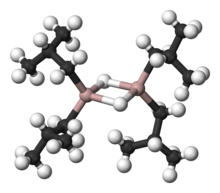
Back مركب ألومنيوم عضوي Arabic Enllaç C-Al Catalan Organické sloučeniny hliníku Czech Aluminiumorganische Verbindungen German Compuesto de organoaluminio Spanish Organoaluminio konposatu EU Organoalumiiniyhdisteet Finnish Composé organoaluminique French Reattivi di organo-alluminio Italian 有機アルミニウム化合物 Japanese

Organoaluminium chemistry is the study of compounds containing bonds between carbon and aluminium. It is one of the major themes within organometallic chemistry.[1][2] Illustrative organoaluminium compounds are the dimer trimethylaluminium, the monomer triisobutylaluminium, and the titanium-aluminium compound called Tebbe's reagent. The behavior of organoaluminium compounds can be understood in terms of the polarity of the C−Al bond and the high Lewis acidity of the three-coordinated species. Industrially, these compounds are mainly used for the production of polyolefins.
- ^ D. F. Shriver; P. W. Atkins (2006). Inorganic Chemistry. Oxford University Press. ISBN 978-0199264636.
- ^ M. Witt; H. W. Roesky (2000). "Organoaluminum chemistry at the forefront of research and development" (PDF). Curr. Sci. 78 (4): 410. Archived from the original (PDF) on 2014-10-06.